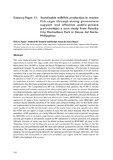Sustainable milkfish production in marine fish cages through strong government support and effective public-private partnerships: a case study from Panabo City Mariculture Park in Davao del Norte, Philippines
- Global styles
- MLA
- Vancouver
- Elsevier - Harvard
- APA
- Help
Share
Abstract
This case study presents the successful practice of sustainable intensification of milkfish aquaculture in marine fish cages under semi-intensive grow-out conditions in the Panabo City Mariculture Park (PCMP) in Davao del Norte, Philippines. Established in 2006, PCMP became operational through the promulgation of a City Ordinance declaring 1 075 hectares of municipal waters in Panabo City as a Mariculture Development Zone/Park. The operations of PCMP were so successful that in just five years it became the third largest among the 63 operational MPs in the Philippines during 2011, with 86 private investors-locators operating a total of 322 units of cages. At present, a total of 372 units of fish cages are operating in the mariculture park (MP). A combination of factors contributed to the successful operation of PCMP, but the success is usually attributed to the effective partnership between the government (both local and national) and the private sector. The Comprehensive MP City Ordinance that governs the PCMP is strictly implemented and includes, among others, the tenurial rights and access to locators. Regulations on distances between cages are strictly enforced and security measures in the total area are jointly undertaken by the government and the locators. The national government, through the Bureau of Fisheries and Aquatic Resources-National Mariculture Center (BFAR-NMC), provides technical support in all aspects from stocking to harvest during the production cycle. BFAR-NMC staff conduct regular periodic sampling of the stocks and compute feeding rates for the stocks which are implemented by the technicians/caretakers. Likewise, BFAR-NMC staff regularly monitor the water quality of the MP and the health status of the stocks. Since it became operational in 2006, the PCMP did not report a single incident of mass fish kill, which indicates that the technical guidelines of MP operations are strictly followed. Workers are trained and organized into groups by BFAR-NMC such as caretakers, cage framers, netters, harvesters, fish processors, and others, and actively participate in discussions related to MP operations to ensure protocols are properly followed. Harvests of stocks are done by skilled workers trained by BFAR-NMC, all done in the “Bagsakan Center” or fish landing area and are well-coordinated. The support facilities in the fish landing area are provided by both the local and national government and the PCMP Producers Association. The operators provide complete data for their operations to BFAR-NMC for record keeping. The strong partnership between the national government through BFAR-NMC, the local government unit, the investors, as well as the acceptance and support from the community for the PCMP is the hallmark of its success.
Suggested Citation
Ayson, F. G., Ventura, A. M., & de Jesus-Ayson, E. G. (2016). Sustainable milkfish production in marine fish cages through strong government support and effective public-private partnerships: a case study from Panabo City Mariculture Park in Davao del Norte, Philippines. In W. Miao & K. K. Lal (Eds.), Sustainable intensification of aquaculture in the Asia-Pacific region. Documentation of successful practices (pp. 122–129). Bangkok, Thailand: FAO.
Type
Book chapterISBN
9789251090657Collections
- Books and Book Chapters [123]

